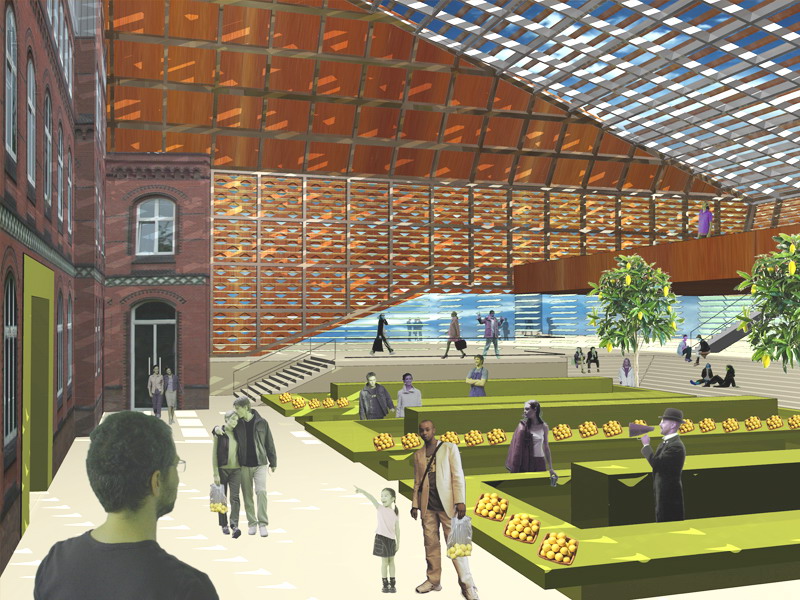Innovative Architektur seit 1970
Hafenamt



Q3 „Am Alten Hafenamt“
Die städtebauliche Neuordnung des Überseequartiers transferiert das Baudenkmal „Altes Hafenamt“ an einen „neuen Ort“. Umgeben von 7-geschossigen Neubauten droht das Gebäude in seiner Proportion von den Nachbarn erdrückt zu werden und zum Relikt zu verkommen. Der Entwurf nimmt diese Problematik auf und versucht hinsichtlich Integration, Größe und Dominanz, beide Gebäude – historisches Hafenamt und neue Markthalle – als ein Gesamtensemble zu verbinden. Die neue Markthalle wird als eigenständiges Gebäude aus der geometrischen Ausrichtung der Dachlinien und -flächen des Alten Hafenamtes entwickelt. Der Neubau greift schützend über die nördliche Dachfläche und bildet, obwohl baulich getrennt, ein gemeinsames Ganzes. Es entsteht ein neuer proportionaler Zusammenhang. Mit der größeren Baumasse und seiner flächenmäßigen Ausdehnung schafft es das Ensemble nun, sich in der neuen städtebaulichen Ordnung und Maßstäblichkeit zu behaupten.
Mit dem Freihalten der übrigen Fassaden des Alten Hafenamts und der damit einhergehenden städtebaulichen Erfahrbarkeit des Gebäudes, wird ein Teil der Baugeschichte dieses Ortes bewahrt und im Gedächtnis des Quartiers und der Menschen verankert. Die Materialkomposition bzw. -verbindung der rauen Materialien Klinker und Cor-ten-Stahl, soll an die einstmals hafenbezogene Nutzung erinnern. Das große Volumen der Markhalle weckt Assoziationen an die mächtigen „Stahlwände“ der Frachtschiffe, die auf dem Gelände des Überseequartiers in früheren Zeiten gelöscht und beladen wurden.
Project Description
Q3 „Am Alten Hafenamt“
The new urban planning order of the overseas quarter relocates the historical Old Port Office. Surrounded by modern seven-storey buildings, the old building is threatened with being dwarfed out of all proportion and reduced to a run-down relic by its neighbours. The project has taken on this problem and attempts to combine both buildings -Port Office and Market Hall– regarding integration, size and dominance. The new Market Hall is to be developed as a free-standing construction from the geometric alignment afforded by the roof landscape of the Old Port Office. The new construction reaches protectively over the northern roof area, albeit as a separate construction, to create a comprehensive unit. A new proportional context is the result. With the aid of the greater construction mass and its extent in area, the ensemble succeeds in maintaining itself proportionately in the new urbanistic order.
With the freeing-up of the remaining facades of the old Port Office and the concomitant urbanistic presence of the building, something of the history of this locality is preserved and anchored in the memory of both the quarter and the people. The material composition and combination of raw materials -clinker and surface-rusted steel– are intended to remind one of the port-related activities once carried out here. The spaciousness of Market Hall conjures up associations of the mighty steel walls of the freighters that were loaded and unloaded in the overseas quarter zone in earlier times.
Q3 „Am Alten Hafenamt“
Markthalle und Büros im Überseequartier der Hafencity, Hamburg
Q3 „Am Alten Hafenamt“
The Old Port Office – Überseequartier Hafencity, Hamburg

Q3 „Am Alten Hafenamt“
Markthalle und Büros im Überseequartier der Hafencity, Hamburg
Q3 „Am Alten Hafenamt“
The Old Port Office – Überseequartier Hafencity, Hamburg


Projektbeschreibung
Q3 „Am Alten Hafenamt“
Die städtebauliche Neuordnung des Überseequartiers transferiert das Baudenkmal „Altes Hafenamt“ an einen „neuen Ort“. Umgeben von 7-geschossigen Neubauten droht das Gebäude in seiner Proportion von den Nachbarn erdrückt zu werden und zum Relikt zu verkommen. Der Entwurf nimmt diese Problematik auf und versucht hinsichtlich Integration, Größe und Dominanz, beide Gebäude – historisches Hafenamt und neue Markthalle – als ein Gesamtensemble zu verbinden. Die neue Markthalle wird als eigenständiges Gebäude aus der geometrischen Ausrichtung der Dachlinien und -flächen des Alten Hafenamtes entwickelt. Der Neubau greift schützend über die nördliche Dachfläche und bildet, obwohl baulich getrennt, ein gemeinsames Ganzes. Es entsteht ein neuer proportionaler Zusammenhang. Mit der größeren Baumasse und seiner flächenmäßigen Ausdehnung schafft es das Ensemble nun, sich in der neuen städtebaulichen Ordnung und Maßstäblichkeit zu behaupten.
Mit dem Freihalten der übrigen Fassaden des Alten Hafenamts und der damit einhergehenden städtebaulichen Erfahrbarkeit des Gebäudes, wird ein Teil der Baugeschichte dieses Ortes bewahrt und im Gedächtnis des Quartiers und der Menschen verankert. Die Materialkomposition bzw. -verbindung der rauen Materialien Klinker und Cor-ten-Stahl, soll an die einstmals hafenbezogene Nutzung erinnern. Das große Volumen der Markhalle weckt Assoziationen an die mächtigen „Stahlwände“ der Frachtschiffe, die auf dem Gelände des Überseequartiers in früheren Zeiten gelöscht und beladen wurden.
Project Description
Q3 „Am Alten Hafenamt“
The new urban planning order of the overseas quarter relocates the historical Old Port Office. Surrounded by modern seven-storey buildings, the old building is threatened with being dwarfed out of all proportion and reduced to a run-down relic by its neighbours. The project has taken on this problem and attempts to combine both buildings -Port Office and Market Hall– regarding integration, size and dominance. The new Market Hall is to be developed as a free-standing construction from the geometric alignment afforded by the roof landscape of the Old Port Office. The new construction reaches protectively over the northern roof area, albeit as a separate construction, to create a comprehensive unit. A new proportional context is the result. With the aid of the greater construction mass and its extent in area, the ensemble succeeds in maintaining itself proportionately in the new urbanistic order.
With the freeing-up of the remaining facades of the old Port Office and the concomitant urbanistic presence of the building, something of the history of this locality is preserved and anchored in the memory of both the quarter and the people. The material composition and combination of raw materials -clinker and surface-rusted steel– are intended to remind one of the port-related activities once carried out here. The spaciousness of Market Hall conjures up associations of the mighty steel walls of the freighters that were loaded and unloaded in the overseas quarter zone in earlier times.

